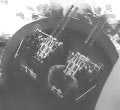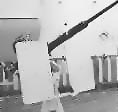Guns
aboard USS Tuscaloosa
and USS Wichita
Tuscaloosa and Wichita shared most of the same guns. As originally constructed, Tuscaloosa had the following armament: 9
- 8" guns; 8 - 5" guns; 8 - .50 caliber machine guns.
USS Tuscaloosa's Guns
Prior to and during the war, Tuscaloosa was subject to many refits and
overhauls. She was eventually outfitted with 16 - 40mm and 19 - 20mm antiaircraft
guns, replacing the machine guns.
Although the Tuscaloosa did not always have all of the following guns, here are
some of the details on and pictures of her guns:
| 8" Main Artillery | 5" Secondary Artillery | 40mm Antiaircraft Artillery | 20mm Antiaircraft Artillery | .50 Caliber Machine Gun |
| Number | 9 | 8 | 16 | 19 | 8 |
| Description | 8" 55 Caliber Surface-Fire Artillery | 5" 25 Caliber Dual-Purpose Artillery | Bofors 40 mm (>1.5 inch) 56 Caliber Multi-Purpose Artillery | Oerlikon 20 mm (0.79 inch) 70 Caliber Anti-Air Artillery | .50 Caliber (1/2 inch) Browning M2 Machine Gun |
| How Mounted | In three turrets of three guns each | Single turrets | In four quadruple mounts | Single mounts | Single mounts |
| Location | 2 triple turrets fore, 1 aft | 4 on each side of the ship | 2 quadruple mounts aft and 2 quadruple mounts on the conning tower | Various | Fore and aft |
| Weight of Gun | 17 tons | 4,270 lbs. | 1,150 lbs. | 150 lbs. | 100 lbs. |
| Length of Bore | 440"
(< 37 feet) | 125"
(10+ feet) | 88+"
(7+ feet) | 55"
(4.5+ feet) | 45"
(< 4 feet) |
| Maximum Elevation | 41° | 85° | 90° | 90° | 90° |
| Maximum Range | 30,050 yards
(17+ land miles) | 14,500 yards
(8+ land miles) | 11,000 yards
(6+ land miles) | 4,800 yards
(2.7 land miles) | 7,400 yards
(4.2 land miles) [effective = 2,600 yards (1.5 miles)] |
| Rate of Fire per barrel | 3-4 rounds per minute
| 15-20 rounds per minute | 160 rounds per minute (120 rpm when barrel elevated) | 450 rounds per minute | 500 rounds per minute |
| Weight of Projectile | 335 lbs. | 54 lbs. | 2 lbs. | 0.27 lbs.
(4.3 oz.) | 0.1 lbs.
(1.6 oz.) |
| Ceiling | n/a | 27,400 feet at 85° | 22,800 feet at 90° | 10,000 feet at 90° | 15,000 feet at 90° [effective = 5,000 feet] |
Notes
| A 1930's refinement of a 1920's design. Not a particularly fast rate of fire, but the heavier shells (compared to the 260-pound shells used by earlier heavy treaty cruisers) were quite effective. Only some of the ships in the New Orleans class (but all of the next three classes of heavy cruisers) had this variation of the 8" gun, capable of firing the super-heavy 335-pound shell. | Developed in the 1920s. Its "dual-purpose" was antiaircraft (good for this purpose with its relatively short bore providing maneuverability) and also surface fire (adequate). | Swedish design introduced in USN in 1942. Although a heavy antiaircraft gun found only on cruisers or heavier ships, it was very effective because it was firing a substantial two-pound projectile and, in a quadruple mount, its rate of fire was 480 rounds per minute. | Swiss design introduced in USN in 1940. A reasonably good free-swinging antiaircraft gun, it was a great improvement over the .50 caliber machine gun. | Developed in the 1920s. Not very effective in an antiaircraft role (note the small size of projectiles).
|
See the Glossary for a discussion of the word "caliber".
It would not be possible for guns to be used this way (nor would it
make sense to try), but if every gun on board were fired at its theoretical
maximum rate for one minute, the primary (8") and secondary (5") guns would
fire a total of more than 10 tons of projectiles, and the antiaircraft guns would
fire a total of more than 3 tons of projectiles.
PICTURES
Below are pictures of the guns. These pictures are not from the Tuscaloosa or Wichita, but show the same guns.
USS Wichita's Guns
Wichita's main guns were the same 9 - 8" 55 Caliber Surface Fire Artillery as in Tuscaloosa. They were arranged similarly in three turrets of three guns each: two turrets located fore in a superfiring position and one located aft.
Her secondary guns were 8 - 5" 38 Caliber Dual-Purpose Artillery, which were the successor to the earlier 25 Caliber 5" guns used aboard Tuscaloosa. This later version possessed much more power and range than the earlier.
As with Tuscaloosa, Wichita was originally outfitted with .50 Caliber Machine guns for antiaircraft purposes. Similarly, these ineffective guns were later replaced by 40mm and 20mm antiaircraft artillery.
Here are some of the basic statistics for Wichita's 5" guns:
5" Secondary Artillery
Description: 5" 38 Caliber Dual-Purpose Artillery
Weight of gun: 3,200 lbs.
Maximum elevation: 85 degrees
Maximum range: 18,200 yards (10+ land miles)
Rate of fire per barrel: 15-20 rounds per minute
Weight of projectile: 55 lbs.
Ceiling: 32,700 feet at 85 degrees.
[ Home | History | Pictures | Construction | Guns | Seaplanes | Treaty ]
[ Naval Covers | Glossary | Crew | Veteran's Association ]
[ Links | Contact | Site Guide ]



 Front view of a 20mm gun from an unidentified ship.
Front view of a 20mm gun from an unidentified ship.




 Overhead view of a 20mm gun from an unidentified ship.
Note the advanced sight which replaced the simple ring sight.
Overhead view of a 20mm gun from an unidentified ship.
Note the advanced sight which replaced the simple ring sight.





